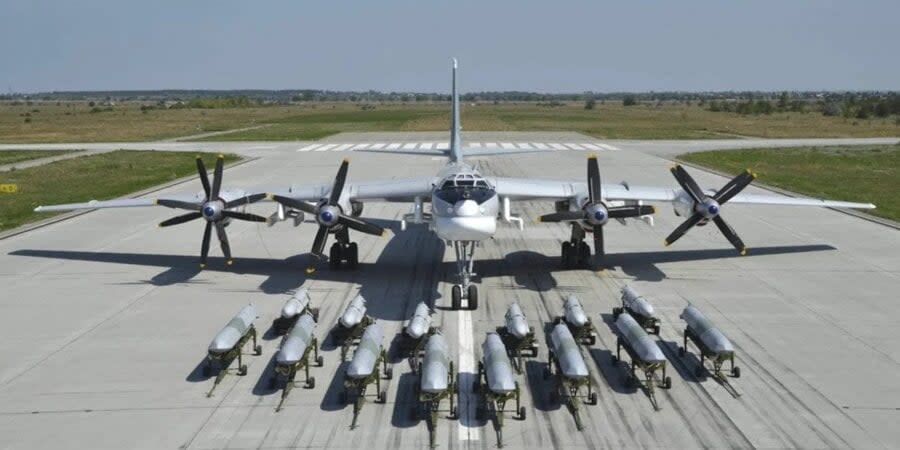Russia’s Tu-95MS strategic missile carrier – what you need to know about its role in attacking Ukraine

Here's how dangerous this machine is and what its vulnerabilities are.
History
The warplane is the same age as Putin.
The development of the long-range bomber with an arrow-shaped wing began in the days of Stalin, when the USSR realized that it was lagging behind the United States in the development of military aviation. The Tu-95 prototype made its first flight in 1952, a month after the current Russian dictator was born. The aircraft was put into production in 1955.
Still, the Tu-95 cannot be considered completely outdated. For decades, the Soviets and Russians have modified the aircraft. In fact, one modification – probably by accident – turned into the passenger Tu-114. Today, the Russian Aerospace Forces (VKS) mainly use the Tu-95MS, the world's only bomber-rocket carrier with turboprop engines. The oldest aircraft is about 40 years old, with the newest produced in August 1992.
By the end of 2021, experts counted about 60 Tu-95MS and Tu-95MSM, but, as Defence Express notes, the actual number of combat-ready vehicles of this model is much lower.
"At the moment, the Ruscists have engaged a maximum of 20 Tu-95MS aircraft for strikes on Ukraine, and a maximum of 10 aircraft for joint flights with China's strategic aviation in 2022. It seems that the conclusion is that the real number of combat-capable Tu-95MS is a maximum of 50% of the number ‘on paper’," the specialized military outlet calculated.
Some of these aircraft were handed over to Russia by Ukraine as part of an agreement to pay off gas debts from the 1990s.
Main characteristics
Crew: 7 people
Length: 49 m
Wing area: 290 square meters
Maximum speed: 830 km/h
Practical range: 10,500 km
Maximum combat payload: 20,800 kg
Applications and weaknesses
As can be seen from the specifications, this is a rather slow-moving and very large aircraft with an unusual wing shape. But it doesn't need speed: the main task of the Tu-95MS is to fly over a long range with a load of missiles. They are launched in the stand-off engagement mode, without needing entry into the enemy's active air defense area.
The Kh-55 missile can cover 2,500 km, the Kh-101’s range is 5,000 km. There were Tu-95 models designed for the use of Kh-22s, but they have now been written off. Theoretically, the Kh-47 (Kinzhal) can also be launched from type of aircraft.
Read also: What a defector engineer from Russia can tell the U.S. about Tu-160 strategic bombers
There is a nuance. The design included a rack for six Kh-55 nuclear missiles (or similar non-nuclear Kh-555). When Russia developed the new Kh-101, they decided it to mount on Tu-95MSM pylon suspensions. There are 10 such suspensions. In reality, according to retired military pilot Roman Svitan, no aircraft ever takes off for a combat mission fully loaded with missiles. One of the reasons is the wear and tear on the airframe. Another, Svitan said, "every second Kh-55 falls down instead of hitting the target" as these missiles are so old.
As with the Tu-22M3, no one thought that the Cold War "weapon of retaliation" would be used in a conventional war of the 21st Century. However, the dark genius of Putin's military leaders found a use for the Tu-95MS, first to launch cruise missiles at Syrian cities in 2016-2017, and now at Ukraine.
Previously, both the Kh-55 and Kh-101 were refueled and loaded into aircraft only at the Engels air base. This was a gross mistake by the Russians. On Dec. 5, 2022, unidentified drones attacked the airfield. Satellite images showed damage to at least one Tu-95 bomber. After that, almost all combat-capable missile carriers were moved beyond the Arctic Circle to the Olenya base, which increased the time needed to reach the missile launch site.
After 15 months of war, the effectiveness of Russian strategic aviation has drastically decreased. 'If from the beginning of Russian aggression, according to military expert Serhiy Zhurtsa, Ukraine intercepted 30-50% of long-range cruise missiles, the interception rate is now consistently over 80% - while half of those not intercepted fail to reach their target anyways.
Russia, however, continues its terrorist attacks, hoping to break through Ukrainian air defense with a massive launch of non-nuclear Kh-55s, Kh-555s, and Kh-101s.
'If from the beginning of Russian aggression, according to military expert Serhiy Zhurtsa, Ukraine intercepted 30-50% of long-range cruise missiles, the interception rate is now consistently over 80% - while half of those not intercepted fail to reach their target anyways.
We’re bringing the voice of Ukraine to the world. Support us with a one-time donation, or become a Patron!
Read the original article on The New Voice of Ukraine

